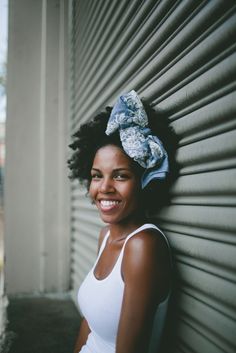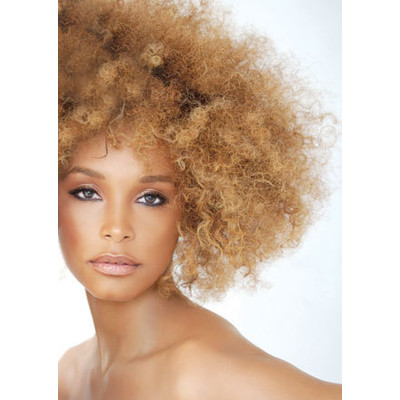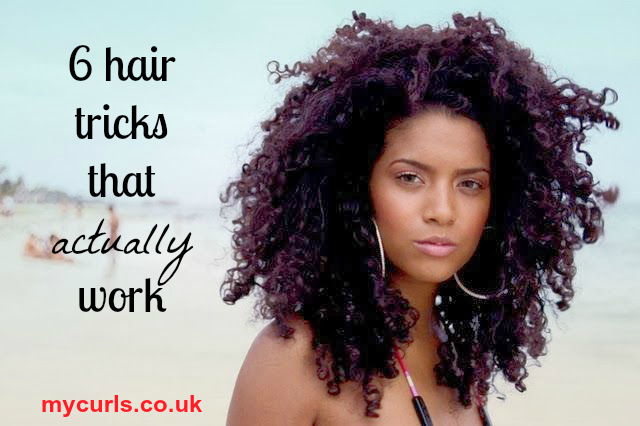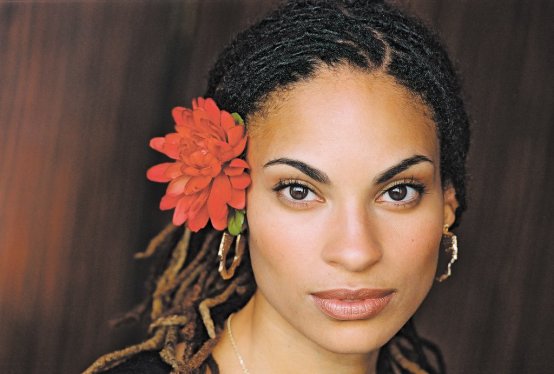Category: curly hair routine night time
Nappy Hair is Strong Hair: Tasha Smith
I recently spotted this wonderful video of actress Tasha Smith discussing black hair and I absolutely love it!
One of the takeaway quotes for me was when she said:
“Nappy hair is strong hair.”
I love that!
For so long, many of us have deemed our kinky hair as being weak, broken, fragile but in actuality our kinks are strong.
I’ve heard many people (women and men equally) describe kinky hair as “tough” in a derogatory way but we need to swap that word with strong.
Tough gives the implication that our hair is hard to manage, hard to deal with but it’s not.
As us naturally curly girls know, with the right management and tools our hair is really quite easy to handle.
It’s far from being “tough.”
So, the next time someone says you have hard to manage hair, look them in the eye and tell them:
My hair is strong!
Check out the video below and leave a comment sharing your thoughts.
HAIR TALES_TASHA SMITH from MADFREEtv on Vimeo.
Victoria xo
4 Hairstyles That Will Make You Ditch Your Bonet
There’s a lot of controversy about whether hair bonets are a YAY or NAY for curly girls.
Although they’re great for protecting curls, many men and women feel as if they’re not exactly the cutest of choices when it comes to helping you look great at night time.
So, what’s a girl to do when she wants to look cute for bed but always wants to make sure her tresses are protected?
It’s simple.
She simply needs to check out these gorgeous hairstyle options that will make sure you can protect your curls whilst still looking smoking hot in the bedroom.
What I love about these styles are that they enable you to look great at night and then wake up with perfect hair.
If you like these styles, please share them with a friend. It could just help her to feel and look amazing during the day and at night.
6 Drop Dead Gorgeous Curly Hairstyles For Spring
With the sun shining and the weather heating up, it’s the perfect time to throw away some of the not-so-fun winter protective styles and opt for far more fun natural hairstyles!
I’ve been wearing my hair in braids all winter and now I’m ready to throw them out and rock my curls!
Can I get an Amen in the comments if you’re feeling the same?
The problem with wearing braids, weaves or other protective styles that don’t involve your real hair is that you get so used to them that it becomes difficult to remember how to style and care for your real hair.
I’ve gone through this so many times which is why I’ve been resistant to wearing my hair in braids for long periods.
In fact, this is the first year in a very long time where I’ve worn braids the whole of winter. I never want to be one of those people who is so obsessed with fake hair that I have no idea how to handle my real curls.
So what do you do when you’ve had your hair in braids, weaves etc and can’t remember how to style your natural hair?
You head over to THIS blog and read a blog post like this 🙂
To give you a sprinkle of hairspiration, we’re sharing 6 of the most drop dead gorgeous curly hairstyles for spring.
Take a look at the pictures below and leave a comment sharing which style you love the most.
Wishing you a wonderful Easter,
Victoria x
The Final Word On Leave-In Conditioner
If you’ve been reading about maintaining your natural hair for any length of time, you will have surely come across the innumerable articles and mentions devoted to a simple, yet unavoidable, accessory – leave-in conditioner.

To the uninitiated, the dizzying array of jargon and marketing lingo can be at best baffling and at worst wholly off-putting.
Read on below as we attempt to separate the kinks from the kooks and decode the mystery of leave-in conditioner once and for all.
1. What good is it, anyway?
Leave-in conditioner was created in order to reinforce the hair’s natural oils with strength and / or moisture – providing increased ease of styling and assisting in detangling along the way without the usual downsides of weighing down the hair and creating a visibly unappealing buildup on the scalp.
Of course, these aren’t goals singular to the leave-in brand of conditioner: nearly every other natural hair product you’ll see on the shelves of your local Boots will promise the same, often in as many words.
The difference with leave-in conditioner is that the concoctions are manufactured to be lighter as well as conducive to frequent, daily usage – without the unwanted side effects so irrevocably linked with daily hair care.
It’s best used as a third step in your routine, as a means of rinsing out the deeper and more chemical-heavy conditioners that can only be applied during the washing process itself.
What’s in it?
There are five main ingredients in any leave-in conditioner worth its salt.
1. First and foremost on the list is water – as the most efficient hydration agent found in nature, it should come as no surprise that aqua tops the list. Water typically makes up in excess of 60% of the final formula of the conditioner, and for good reason: your hair simply can’t get enough of it!
2. Jojoba oil is about as pure as a natural oil can get; a quality made clear by your hair’s ready acceptance of it upon application. As well as being hassle-free, this nutrient-rich wonder ingredient has been reported to solve a whole host of problems – dandruff, dry scalp problems, thinning hair and hygral fatigue chief among them.
3. Olive oil may seem like a counter-intuitive choice, as its history of use in the preparation of food leads us to imagine our hair becoming greasier than the Italian takeaway down the road.
Fear not, however: by penetrating the hair shaft and retaining moisture, olive oil adds softness and strengthens the hair follicles themselves. We recommend starting out with a tablespoon or two until your hair grows used to this interesting addition to your haircare toolkit.
4. Castor oil is the be-all and end-all when it comes to maximizing your natural hair’s volume. Owing to its high levels of Omega 6 and 9 fatty acids (the beneficial kind!) as well as an exceptionally healthy ricinoleic acid ratio, castor oil is a must-have for anyone who wants to take their natural ‘do to the next level.
Whew! Pretty tiring, right? All those chemicals can get to a gal – and that’s before we’ve even put anything into our hair! While it’s important to understand what it is that makes up the product you’re massaging into your scalp every day, it’s as crucial to try not to be put off by all the scientific jargon.
We encourage your own research into the brand of your choice, as well as consultation with your physician if any extraneous problems rear their ugly head. If you begin to feel daunted, however, do your best to remember leave-in conditioner cannot be that chemically heavy, purely by virtue of its needing to be light and airy in order to effectively cleanse your scalp of the chemicals you just washed it with.
Leave-in conditioner can be a powerful weapon in your haircare arsenal – don’t let the “wall of noise” phenomenon that can arise from too much information put you off and make you miss out on something that could be a potential game-changer for you and your hair.
Do you have any experiences with leave-in conditioner you’d like to share?
Let us know in the comments below!
Hair Overwhelm: Has The Natural Hair Movement Has Caused More Harm Than Good?
As much as I love being a naturalista and I’m incredibly proud of how far the natural hair scene has progressed over the past decade or so, I can’t help but sometimes feel very overwhelmed by the amount of information, advice and trends that constantly crop up. The hardest thing is the fact that much of the advice is contradictory.
Some naturals claim that it’s great to detangle with a wide-toothed comb whilst others say that we should abandon combs all together!
Some say that brushes are best whilst others say that our fingers are the only combs we need. Which is it? What do you do?
To comb or not to comb? That is the question!
Then there are the claims about naturals who’ve achieved rapid hair growth through regimens like the LOC and inversion methods.
If you’ve tried either, you might have found a hair growth panacea that works for you or you might have discovered that too much of any regime simply drives you and your hair nuts!
I’ve been natural for several years now and I’ve been following the natural hair movement for probably around 8 years (yes, it’s been that long). Back in the day there were simply a few forums that catered to women who wanted healthier, longer hair but nowadays, there are thousands, perhaps tens of thousands of blogs, websites, forums, Instagram accounts and Facebook pages that share a plethora of advice on natural hair care.
Whilst it’s great that we have so much more information available, it also has a downside.
Namely, the fact that when there’s too much information, you don’t know where to look or where to start.
It can be difficult.
So this begs the question, how do naturalistas find both balance and clarity in a wold that’s filled with contradictory advice and too many options?
How do we avoid becoming the victims of a choice paradox?
How do we find our own unique path to healthier hair?
What’s the solution?
Now, I’d love to hear your thoughts.
Have you ever felt overwhelmed by the overload in hair care information?
How do you deal with it?
Leave a comment below sharing how you feel.
PS. This might have been my most honest and open blog post yet but I’ve come to realise that honesty and vulnerability are catalysts for personal growth. I hope that in sharing how I feel, I’ll open up discourse for other women who might be feeling the same way.
Here’s to hair happiness,
Victoria xo.
Will dyeing my hair cause it to break?
Sometimes as a naturalista, you might feel as if your hair could do with a bit of a change. For some people change can come in the form of straightening their hair for a few days, adding clip-ins or wearing a weave. However, if you’ve been thinking about dyeing your hair and you’re unsure whether it will cause your hair to break, consider these things.
Hair dye can cause damage to your hair if your hair is already suffering from some form of damage. That includes breakage, excess shedding or scalp dryness.
To reduce the chances of your hair breaking when it has been dyed, it’s best to only dye your hair if it is in optimal condition prior. If you’ve noticed that your hair shows any signs of damage whatsoever, then don’t dye it. Simply wait until it’s in a better condition before going ahead.
Another thing to bear in mind is that semi-permanent dyes (which last for about 5-7 washes) are a better alternative if you’re simply looking to add colour to your hair or you want a quick change of style or a new look. permanent dyes aren’t necessarily damage-free but they are less strenuous on your hair.
Furthermore, if you want to avoid breakage when dyeing your hair, make sure that you keep your hair very well conditioned and moisturised after colouring it. Hair dyes are notorious for causing dryness which in turn leads to thinning and breakage and it’s for this reason that so many women experience signs of damage after dyeing their hair. To keep your newly coloured hair in great condition, deep condition it at least once a month and co-wash (which means washing your hair with conditioner only) on a weekly basis.
Be sure to trim any damaged ends and moisturise your hair like there’s no tomorrow! Seriously, moisturising can literally make or break your hair’s health. I can’t stress the importance of moisturising it.
If you’re unsure about how to moisturise, do the following:
- Co-wash your hair once a week
- Apply a silicone-free, moisturising hair lotion to it twice a day
- Follow with a good, natural oil like jojoba or olive oil
- Repeat steps 2 and 3 twice a day. Try moisturising once in the morning and once at night.
Keeping your hair in good condition after it has been coloured isn’t impossible. You just need to be more mindful of your hair’s health and fragility and moisturise on a regular basis.
How to keep your hair protected during the winter
It’s common knowledge that winter weather can wreak havoc on natural hair. It’s therefore crucial that in these very cold months, you keep your hair protected and cared for.
As a busy woman who’s preoccupied with your career, life and family, it’s important that you find ways to make protecting your hair as easy and effortless as possible.
So how can you do this?
One o f our favourite ways to care for your hair during the winter months is to simply wrap it up by keeping it as covered as possible.
f our favourite ways to care for your hair during the winter months is to simply wrap it up by keeping it as covered as possible.

You can do this by playing with scarves, head-ties, hats and headbands.
What’s great about using accessories to protect your hair is that not only does your hair stay in top notch condition, it also keeps you warm and who doesn’t want to be warm during when it’s freezing outside?
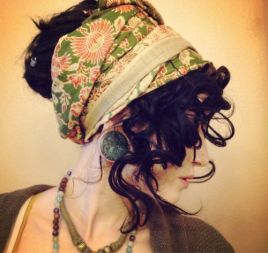
What’s your favourite hair accessory for the winter season?
Leave a comment below sharing it with us.
Victoria
Founder, MyCurls.co.uk.
Natural Hair Care: How To Get Amazing Curl Definition
How do you get my curls to be really defined?
This is one of the most common questions that I get asked about caring for naturally curly/unrelaxed hair.
Here are 3 ways to get amazing curl definition.
And don’t worry, you won’t need to spend hours on your hair to get really defined curls.
Step 1
Keep your hair clean through conditioning (co-washing) and not through excessive shampooing.
Over shampooing dries out naturally curly hair and therefore it’s best to shampoo your hair approximately once every 2 weeks or once a week at most.
Instead of shampooing all the time, wash your hair with a silicone free conditioner that does not contain parabens or synthetic oils. A great conditioner will transform your hair so it’s therefore best to be selective about which conditioner you use and don’t be afraid to do these two things:
- Read the ingredients on the label of your conditioner
- Invest in a high quality conditioner
Sometimes people think that the cheapest conditioner is the best but that isn’t always the case. It’s therefore wise to spend more money on a conditioner that is filled with high quality ingredients and is therefore slightly higher in price. I always tell customers that an investment in good hair products is an investment in the health of your hair. Think about it, what’s your hair worth?
Step 2
Play around with twist-outs and braid-outs.
These hair styles can give you incredible curl definition and they work on almost any hair texture. One thing I like to do is to braid or twist my hair at night and then unravel in the morning. That way, I end up with gorgeous curls almost every day. Plus, creating twist-outs and braid-outs isn’t time consuming. Try it!
Step 3
Keep your hair super moisturised.
Curly and afro hair are the driest hair types and that means that our hair needs to be moisturised a lot. To get gorgeously soft and well-defined hair, moisturise once in the morning and once at night. If your hair is wavy or only slightly curly then only moisturise once in the day. As a rule of thumb: the curlier your hair, the more moisture it needs.
Follow these three steps and your hair should be more defined, softer and shinier.
PS. For more hair tips sign up to my free newsletter at mycurls.co.uk.
The Top Six Hair Tips And Tricks That Actually Work
The Top Six Hair Tips And Tricks That Actually Work
From family friends to hairstylists, you may have heard some advice about your strands that doesn’t seem quite right. Well, now you can try these seven tips and tricks that actually work.
Don’t Wash Your Hair Every Day
Unless your hair is incredibly oily, you really do not need to wash it every day. In fact, using shampoo on your hair every day can strip it of natural oils. Once you start with this new hair-washing routine, you might start to notice that your hair feels softer. You may wish to consider conditioning your strands each day still. Talk to your stylist about what is best for your locks.
Use Lotion to Tame Frizz
When your strands are filled with frizz, you’ve probably tried numerous ways to bid it adieu. The next time your hair is misbehaving, run some body lotion or hand lotion over your hair. Generally, you want to avoid doing this near your scalp so that your hair doesn’t look greasy, but it can tame frizz elsewhere. Make sure it is already rubbed in your hands so a minimal amount gets on your hair. A little goes a long way with this method.
Low Ponytail to Reduce Frizz
Perhaps you can’t imagine a hairstyle made for sports and quiet nights at home as being one of your biggest styling tools. After you get out of the shower and once your hair is brushed, put it into a low ponytail. This trick can help to get rid of frizz and flyaways so that you have beautiful hair when you take it out.
Don’t Brush Your Hair
As unusual as it sounds, you should try not brushing your hair, particularly if you have curly strands. When you brush curly hair, you are often bringing frizz to the surface and ruining the natural definition of your locks. Use a wide-toothed comb to go through knots and detangle your hair instead.
Go Natural
Wearing your hair as it is might sound like your biggest nightmare, but it can actually turn out to be the best decision that you ever made. There’s nothing wrong with showing off your natural hair color and texture. Throw in a little gel or hair spray if you need to, and you’ll have a sassy style that displays your true personality.
Turn off the Heat
Even if you want to use some products to style your hair and get a certain look, you don’t always need to use heat to do so. Straighteners, curling irons and blowdryers are great for those big nights out, but constantly putting too much heat on your hair can really damage it in the long run.
Don’t be afraid to think outside of the box a little bit and try some ideas that might have previously sounded strange when it comes to your hair.
This is a guest post written by writing expert Anita Ginsburg.Anita is a freelance writer from Denver, CO and often writes about fashion, health, beauty and family. A mother of two, she enjoys traveling with her family when she isn’t writing. When it comes to her hair, she personally recommends remy hair extensions to add length and keep your hair looking healthy.
For hair care tips and the best curly hair products, visit www.mycurls.co.uk.
Trimming Natural Hair: How To Trim Your Hair With Ease
Trimming or cutting your natural hair can be daunting especially if you’ve typically relied on hairstylists to do it for you.
Despite seeming like a nerve-wrecking thing, trimming your curls is actually not that difficult to do if you follow these 3 simple steps:
1. Always trim/cut with a professional hair scissors. Never scrimp by cutting your hair with a household scissors that just happens to be lying around. If you do that, your hair might potentially become more damaged!
2. To get the best results from trimming always hold the tips of your hair towards the light so that you can clearly see split ends and single strand knots. Sometimes, knots and splits have a way of disappearing or seeming difficult to find. By holding your ends up to the light you’ll be able to see damaged hair far more quickly.
3. Get used to ‘dusting.’ What’s that? It refers to the process of only trimming the unhealthy and damaged parts of your hair and not the rest of it. For example, traditionally, stylists and hair professionals have encouraged us mere amateurs to trim our hair in sections. Whilst this is great if you want your hair to be more even in length, it has the unfortunate downside of causing you to lose both your healthy and unhealthy hair. If you’re looking to retain as much length as possible, only trim off the unhealthy ends rather than trimming your hair in sections. This process is called dusting.
Now it’s over to you: do you have a secret or special method for finding dodgy strands and snipping them? Leave a comment below telling us what you do to keep knots and splits at bay.
PS. if you’re looking to get shinier curls this summer, check out our range at MyCurls.co.uk.
Till next time,
Victoria xo
Founder, MyCurls.


